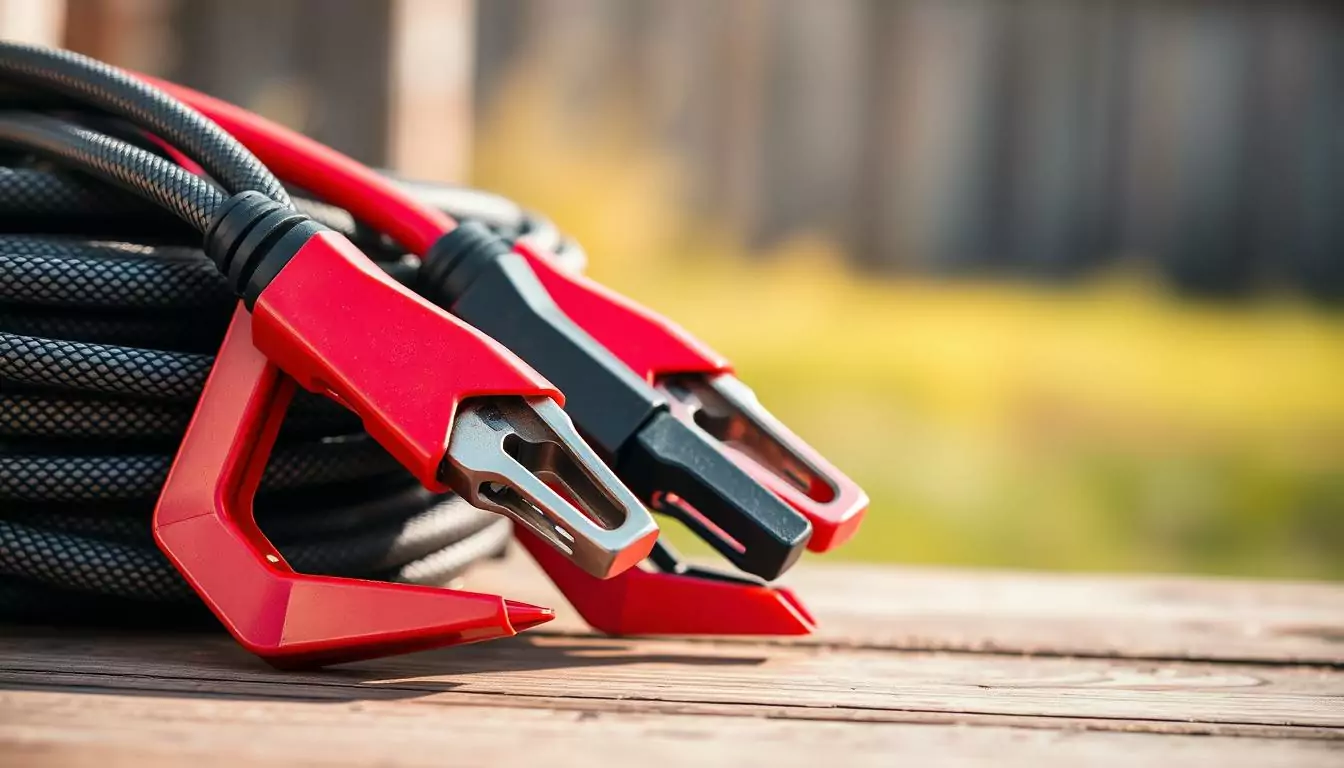A cold winter morning left me stranded with a dead car battery. I had no heavy duty booster cables, and panic set in. This experience taught me the importance of being prepared for car troubles.
I’m sharing my knowledge about jumper cables to help you avoid similar situations. Being ready for battery emergencies is crucial, whether you commute daily or take weekend road trips.
This guide covers everything about car battery cables. You’ll learn about key features and how to choose the right set. We’ll explore what makes jumper cables effective and safe to use.
Key Takeaways
- Heavy duty booster cables are essential for jump-starting vehicles
- Proper cable gauge and amperage ratings are crucial for effective jump-starts
- High-quality insulation and clamps ensure safety during use
- Cable length should be appropriate for your vehicle type
- Understanding safe jump-starting procedures is vital
- Choosing the right jumper cables can make all the difference in an emergency
Understanding Heavy Duty Booster Cables and Their Essential Features
Heavy duty booster cables are vital for drivers facing emergencies. These power cables can restart your vehicle when it won’t start. Let’s explore the key features of effective and reliable cables.
Cable Gauge and Amperage Ratings Explained
Cable gauge determines wire thickness and current capacity. Lower gauge numbers mean thicker wires for high amperage cables. Most jump starters use 4 to 6 gauge cables.
Amperage rating shows how much current cables can safely handle. This is crucial for choosing the right cables for your vehicle.
| Cable Gauge | Max Amperage | Suitable for |
|---|---|---|
| 4 | 500A | Large trucks, SUVs |
| 6 | 400A | Mid-size cars, small trucks |
| 8 | 300A | Compact cars |
Insulation and Clamp Quality Requirements
Quality insulation shields you from shocks and prevents short circuits. Look for cables with thick, flexible rubber coating. Clamps should be made of sturdy copper or brass.
Strong springs ensure a secure connection. This is essential for safe and effective jump-starting.

Length Considerations for Different Vehicle Types
Cable length is crucial when jump-starting vehicles. For most cars, 16-foot cables work well. Longer cables suit larger vehicles or tricky parking spots.
Keep in mind that longer cables can cause some power loss. Balance length with practicality for best results.
- 16 feet: Standard length for most cars
- 20 feet: Good for SUVs and trucks
- 25 feet: Ideal for large trucks or RVs
Understanding these features helps you choose the right emergency power cables. You’ll be prepared for any vehicle starting issues.
Professional Tips for Safe Jump-Starting Procedures
Jump-starting a vehicle can be scary, but it’s easy with the right steps. Here are key tips for safely using automotive booster wires and commercial booster cables.

Park the vehicles close, but not touching. Turn off both engines and all electrical parts. This sets the stage for a safe jump-start.
- Connect the red clamp to the dead battery’s positive terminal
- Attach the other red clamp to the working battery’s positive terminal
- Connect the black clamp to the working battery’s negative terminal
- Attach the remaining black clamp to an unpainted metal surface on the dead car’s engine block
Start the working vehicle and let it run for a few minutes. Try to start the dead vehicle. If it works, keep both engines running for about 15 minutes.
“Always wear safety glasses and gloves when handling truck jumper cables. Batteries contain corrosive materials that can cause serious injury.”
Disconnect the cables in reverse order. Don’t let the clamps touch while connected to avoid sparks.
| Do | Don’t |
|---|---|
| Check cable insulation for damage | Smoke near the battery |
| Keep cables away from moving parts | Connect to the negative terminal of a dead battery |
| Ensure proper polarity | Let the vehicles touch during the process |
These guidelines will help you jump-start any vehicle safely. You can use them for compact cars or heavy-duty trucks. Commercial booster cables or truck jumper cables will both work well.
Choosing the Best Heavy Duty Booster Cables for Your Needs
Let’s explore how to pick the right heavy gauge battery cables for you. We’ll look at key factors to consider when shopping for automotive booster wires. This knowledge will prepare you for any battery emergency.
Consider how often you’ll use the cables. Mechanics should invest in top-quality heavy duty booster cables. For occasional use, a mid-range set might be enough. The type of vehicles you work with is important too.
Larger engines need thicker gauge wires to handle higher amperage. Storage is another factor to think about. Longer cables are versatile but can take up space.
If your car has limited room, choose a compact set of automotive booster wires. Look for cables with sturdy carrying cases for organization and protection. By considering these points, you’ll find the perfect heavy duty booster cables.
With the right set, you’ll be ready to jump-start any vehicle safely. You’ll feel confident handling battery emergencies whenever they arise.
